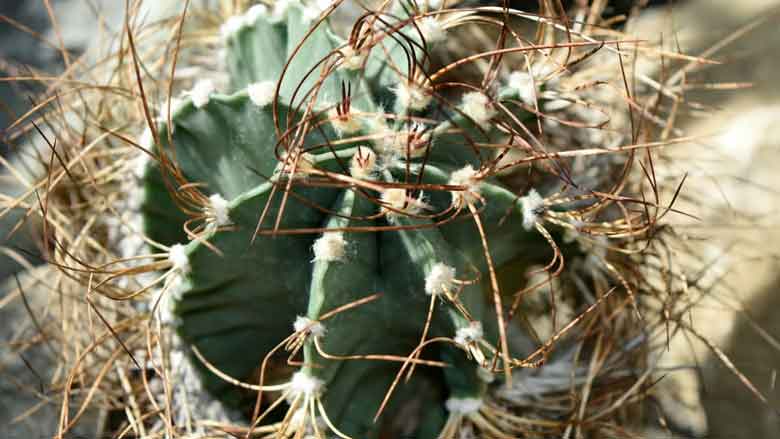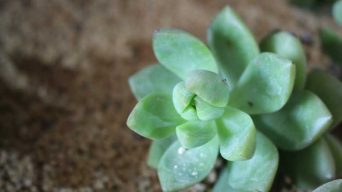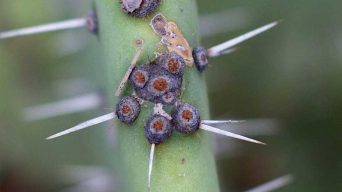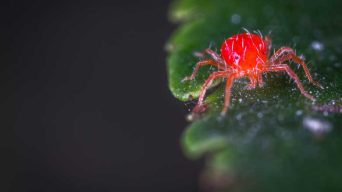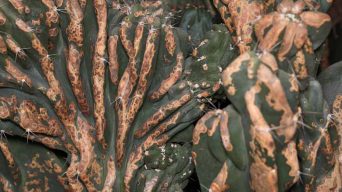Mealybugs infest cactus plants, feeding on sap and hindering growth. Identify them by white fluff, egg sacs, and sticky secretions. Causes include overwatering, poor airflow, and infested plants. Treat with insecticides, neem oil, or beneficial insects. Prevention involves plant inspection, cleanliness, and proper watering. Regular checks and swift action ensure a mealybug-free cactus.
Dealing with a mealybug infestation on your cactus plants? You’re not alone.
Mealybugs are a common issue for cacti, and eliminating these pests can pose a challenge.
However, there are straightforward steps you can take to effectively eradicate mealybugs from your cactus plants.
This article provides comprehensive information on mealybugs and their impact on cactus plants, offering valuable insights for your plant care.
What Are Mealybugs?
Mealybugs are mealy-looking bugs that can invade your cactus plants.
Mealybugs feed on the sap of a plant, and they do not have wings or antennae, making them easy to identify.
They tend to be found in clusters around the branches and stems of affected plants.
There are many mealybug species, but mealybugs that feed on cactus plants have a rough waxy covering, which gives them their name.
They vary from light to dark brown and are often found along the veins of leaves or flowers.
The most common mealybug species on cactus plants are the citrus mealybug (Planococcus citri) and the long-tailed mealybug (Pseudococcus longispinus).
Causes of Mealybugs on Cacti?
Mealybugs pose a frequent issue for cactus plants.
Their prevalence has increased globally, manifesting in greenhouses and homes.
These pests sustain themselves by extracting sap from succulent plants, posing a threat to various species such as cacti, agave, aloe vera, jade plants, and more.
The primary contributors to mealybug infestations on cacti include:
Overwatering
Mealybugs are most often found in moist environments, where the mealybugs can feed off of plants that are watered too frequently or not allowed to dry out completely.
Poor Airflow
For mealybug eggs to hatch and thrive, they require a humid environment, particularly when infesting cacti.
When indoor humidity levels persistently stay elevated, it can lead to a rapid proliferation of mealybug populations.
Temperature Extremes
Mealybugs thrive in hot and humid conditions, while they may die off during the winter months when temperatures drop below 50 F (or approximately 11 C).
High Humidity
Mealybugs are attracted to moist areas with high humidity.
They can be found in windowsills, potted plants that live indoors or outside, and even greenhouses where humid conditions prevail year-round.
Poor Soil Quality
The presence of mealybugs on your cactus may indicate inadequate soil quality, prompting the need for replacement.
Plants cultivated in all-purpose or low-quality soils exhibit reduced growth, rendering them more vulnerable to pest infestations like mealybugs.
Infested Plants
When you bring home new houseplants, you must know they may harbor pests like mealybugs.
These insects might be concealed in the plant’s soil or attach themselves to its leaves and branches during relocation.
Identifying a Mealybug Infestation on Cactus Plants
It is easy to spot a mealybug infestation on cactus plants.
Mealybugs are tiny white bugs that look like fluff or cotton at the base of leaves and stems, especially near where new roots emerge.
They have piercing-sucking mouthparts, which they use to feed off plant sap.
In addition to this harm, their large numbers can cause damage by blocking out light needed for photosynthesis in the affected areas.
The most common signs of a mealybug infestation on cacti are:
White Bugs or White Fluff
Mealybugs, commonly found on cactus plants, manifest as white fluff in their appearance.
These small, oval-shaped insects possess a waxy, cottony exterior, hence the moniker “mealybugs.”
Distinctive features include two tubes running lengthwise along the bug’s body, presenting as elongated cotton lines upon observation.
White, Cottony Egg Sacs
Mealybugs can also produce white, waxy-looking egg sacs typically found on the soil underneath plants.
These egg sacs contain 100-400 eggs and will hatch between one to three weeks after being produced.
They may look similar to woolly aphid or scale insect egg sacks, so it is essential to identify the egg sacks before treating houseplants correctly.
Sticky, Honeydew-like Substances on Leaves
Mealybug secretions can look like a sticky, honeydew-like substance left on leaves and stems.
The bugs excrete these secretions as they feed, usually left on the top of the leaves where they feed.
This substance may also attract other bugs, such as ants.
Frass (Mealybug Poop)
Another sign of a mealybug infestation is the appearance of frass on and around plants.
This bug excrement looks like small grains or pieces of sand and may be stuck to leaves with honeydew secretions.
Shriveled or Wilted Leaves
Mealybugs can cause leaves to turn yellow or brown, wilt, and fall off.
The bugs feed on plant sap, which contains water that helps keep plants healthy.
Curled and Distorted Growth
Mealybugs can cause leaves to curl, twist, or become distorted. This is because they feed on sap containing nutrients needed for plant growth.
Presence of Ants
Ants are often present in areas where mealybugs feed.
This is because they like to eat the honeydew secretions that bugs produce while feeding on plants, and ants will also protect mealybugs from predators trying to get rid of them.
Ant colonies can be very large if there’s an infestation nearby.
Flower Drop
Mealybugs can also cause flowers to drop.
This is because they feed on plant sap, which contains the nutrients needed for flower production.
So if no more nutrients are available, flowering will stop even though it hasn’t finished yet.
Effectively Treating Mealybug Infestations
Upon identifying signs of mealybugs on your cactus plants, prompt action is essential. Begin by isolating the affected plant to curb the potential spread of these pests to nearby plants.
To effectively treat mealybug infestations on cactus plants, consider the following methods:
Use an Insecticide Spray
An excellent product to use is a horticultural oil or insecticidal soap spray.
This will kill off the bugs and their eggs, then wash away secretions that attract ants (which can protect them).
Horticultural oils also coat plant leaves with natural substances, which suffocate the bugs too. Be sure not to get these products on flowers as they may damage them.
Pick Them Off by Hand!
Another way of treating mealybugs on cacti is to pick them off one by one using your fingers or tweezers.
A pest like this won’t be killed if you contact it; you only need to remove it from the houseplant and treat that affected area with insecticidal soap or horticultural oil spray.
Neem Oil Spray
Using neem oil spray can help eliminate mealybugs without killing beneficial insects like ladybugs that prey upon them (and other pests).
You’ll need to prepare this pest control mixture by mixing one tablespoon of organic liquid soap with two teaspoons of 100% pure neem oil in eight ounces of water.
Shake it up well, then spray the solution onto all affected areas as needed.
Use Beneficial Insects
Using biological control methods – such as introducing beneficial insects like ladybugs, lacewings, or parasitic wasps into your garden – can help eliminate an infestation if other treatments don’t work well enough.
These insects feed on mealybugs (and other pests) by laying their eggs inside them, killing off the mealybugs themselves.
Isopropyl Alcohol
An alternative method for addressing mealybug infestations on cactus plants is the application of isopropyl alcohol, commonly known as rubbing alcohol.
Before applying this treatment extensively, conduct a preliminary test by pouring a small amount of the solution on an inconspicuous part of the plant’s stem or leaves.
This precaution ensures you avoid any inadvertent damage to your potted plant in case of harmful chemical reactions.
This method effectively eliminates mealybugs and safeguards your cactus plants.
Water Sprays
Spraying your plant with water can also help kill mealybugs by washing away honeydew secretions and dead bugs stuck to leaves.
However, this method alone won’t be as effective for completely wiping out an infestation as the other treatments do.
Dish Soap
Using dish soap is an effective method for eliminating mealybugs from cactus plants.
The soapy solution efficiently coats the bugs, ultimately suffocating them through their pores.
To apply this treatment, administer a few drops of dish soap to the affected areas. Allow it to sit for approximately one hour, then thoroughly rinse your plant with clean water.
Dry the plant using either paper towels or a soft cloth. This method provides a practical and straightforward solution to combat mealybug infestations on your cactus plants.
Systemic Insecticide
Consider employing a systemic insecticide as an alternative method to address mealybug infestations on cactus plants.
This form of pest control is absorbed by plant tissues, eliminating bugs as they feed, even if immediate evidence of their presence is not apparent.
While results may not be immediate, it typically takes about seven days to observe the effectiveness of this treatment. Remain vigilant for new infestations during this period.
One notable advantage of using systemic insecticides is that spraying the plant externally is unnecessary.
The protection is already integrated within the plant tissues, preventing the appearance of honeydew secretions or deceased bug remains.
Potassium Bicarbonate Soap Spray
To address bug infestations organically, create a solution by combining one teaspoon of potassium bicarbonate (baking soda) with liquid castile soap in half a liter or quart of water.
Transfer the mixture into a misting bottle for more efficient application on affected areas. Reapply every three days until mealybugs are no longer present on your cactus.
Beneficial Nematodes
One final way to eliminate an infestation is by introducing beneficial nematodes into the soil around your plant because they will prey upon and kill off any invaders, such as mealybugs.
These microscopic worms can be used indoors and outdoors, so it’s a good option for those who want to avoid pesticides or harsh chemicals when dealing with this problem.
Preventive Measures Against Mealybugs
Prevention stands as the optimal solution.
Successfully eliminating existing mealybugs on cacti may prove futile if you don’t take measures to prevent their return in the future.
To ensure they do not infiltrate your home or garden again, consider the following general tips:
Check All Plants Before Bringing Them Home!
This is one of the most important rules for preventing an infestation.
A single infected plant will spread disease to every other potted plant in the vicinity, especially if all containers are adjacent near windows or doors.
If you see cracks in stems and leaves and cottony white secretions forming around their bases, don’t buy them because they’re most likely infested.
Don’t Forget to Wash Your Hands!
Maintain cleanliness by consistently washing your hands after handling cactus plants, as mealybugs can easily find their way indoors if hands aren’t washed after contact.
These pests thrive in warm, moist conditions and can enter your home through various routes, such as windowsills or potting soil placed outside seasonally, whether in a greenhouse, shed, porch, or patio.
Always adhere to proper sanitation practices when dealing with plant material, especially if it originates from areas prone to bug infestations.
The diversity of animal species in different regions may surprise you.
Adopting this approach eliminates the risk of anyone unintentionally introducing pests into your home and garden.
Inspect Your Plants Regularly!
You should always check plants for mealybugs before bringing them into the house.
Ensure not to bring plants with sick-looking leaves, stems, branches, and roots inside. If there are small white spots, they might be eggs.
They can be on stems or leaves or, in some cases, on the ground. If you see these, make sure to get rid of them right away because this could mean that there is an infestation nearby.
Keep All Plants Clean!
Ensure all your plants are clean by occasionally washing them with a hose or misting bottle filled with water.
This will get rid of any bugs or eggs that are in your house. This way, they can’t lay more eggs and make more bugs.
You should do this if you see signs of an infestation before things get bad.
If the mealybugs are already on your cactus plants, don’t touch them without gloves.
The secretions from these bugs can make you itchy and uncomfortable. If a mealybug jumps, you could be hurt without realizing it because they usually blend in with their environment well.
Avoid Overwatering!
Overwatering can attract mealybugs to your cactus plants.
These pests thrive in consistently damp conditions, making them prone to infestations.
To deter them, only water your plants when the soil is visibly dry or shows signs of wilting.
This practice will hinder their survival and growth, particularly as mealybugs thrive in high humidity.
Provide Proper Drainage!
Mealybugs thrive in high-humidity environments but require proper drainage to prevent soil saturation.
To deter a mealybug infestation over time, ensuring that the containers housing your cactus plants have sufficient drainage is essential.
To achieve this, opt for containers with numerous holes or ample space, allowing excess water to drain effectively.
This practice prevents soil from becoming excessively soggy, mitigating the risk of root rot and fungal growth that can adversely affect your plants.
Final Thoughts
Mealybugs, like other cactus pests such as spider mites and scale, can be annoying.
You do not want to have Mealybugs in your house or any other location. This is due to the damage they can cause to plants.
If you find mealybugs on cacti, try using one of these methods to get rid of them fast!
They won’t take long once you start cleaning up after this infestation.
After you are done with the treatment, make sure there isn’t another case by keeping an eye out every day while watering the plant.
If anything looks off about the cactus, take action before you have another infestation!

